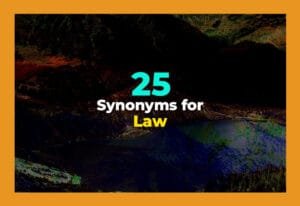The word middle is super common in everyday English, but sometimes you might want to mix it up. Words like center, core, midsection, or hub can be used instead. Each of these words has its own small twist on meaning, depending on context. In this article, we will explore 28 different synonyms for middle with easy examples to help you use them.
28 Different Ways to Say MIDDLE: Another Word for Middle
Center
The word center works as a synonym for middle because it points to the exact point that is equally far from all sides. You can use it in both physical and abstract contexts, like the center of a circle or the center of attention. It gives a clear sense of balance and focus, which makes it very easy to understand. People often say "the center of town" or "center of the stage" when referring to this idea. Using center makes your sentence feel precise and visually grounded. It can also show importance or a main point in a discussion.
- The kids sat in the center of the room during storytime.
- Place the vase in the center of the table.
- He stood in the center of the crowd, waving to everyone.
Midpoint
Midpoint is perfect when you want to indicate the exact middle point in a journey, project, or object. It usually refers to a measurable or calculable middle, like halfway through a race or a line segment. You can use it in both formal and casual conversations. Midpoint helps your listener or reader understand that something is not at the start or end, but right in between. It can also suggest balance or a transition stage in processes. Midpoint is often used in storytelling, sports, or discussions about time or space.
- We stopped at the midpoint of our hike to rest.
- The midpoint of the road is marked by a small fountain.
- She realized she was at the midpoint of her book.
Heart
The heart is used as a synonym for middle because it emphasizes the most important or central part of something. It is more emotional or figurative, like the heart of the city or the heart of the problem. Heart gives a warm, relatable tone and works well in casual speech. It focuses on importance rather than exact location. You can use heart in stories, personal experiences, or when talking about what matters most. It adds depth and feeling to the concept of middle. Heart is often used in writing to make ideas more vivid.
- The heart of the forest was full of old trees.
- She is the heart of our team because she motivates everyone.
- The heart of the city is always busy with people.
Core
Core is similar to heart but slightly more practical. It can refer to the central, most important, or essential part of something, like the core of a fruit or the core idea of a plan. It gives a sense of structure and foundation. You use core when you want to show that something is central and important. It works in both casual and formal contexts. Core makes your language feel solid and grounded. It is often used in discussions about ideas, health, or objects.
- The core of the apple is full of seeds.
- Trust is the core of any strong friendship.
- The core of the lesson was easy to understand.
Hub
Hub is a casual and friendly way to talk about a center, especially of activity. It is often used for places like a hub of transportation, a hub of a city, or a hub of social life. Hub gives a feeling of energy and connection. You can use it when talking about people, events, or locations where things happen. It is perfect for informal conversations. Hub makes your sentence feel modern and active. It shows that the middle is lively and important.
- The airport is the main hub for flights in the city.
- The cafe became a hub for local artists.
- He turned his garage into a hub for friends to hang out.
Nucleus
Nucleus is a scientific or formal way to describe the middle, often of cells, atoms, or groups. It shows that something is the controlling or central part. You can also use it figuratively to describe the central team or idea in a group. Nucleus makes your language sound precise and informative. It works well in science discussions or professional settings. Using nucleus can make your writing feel accurate and intelligent. It focuses on what controls or holds everything together in the middle.
- The nucleus of the atom contains protons and neutrons.
- The small team became the nucleus of a successful project.
- His ideas formed the nucleus of our plan.
Equator
Equator is mostly used for geographical or global contexts, but it represents the literal middle of the Earth. It works as a synonym for middle when talking about balance, heat zones, or global locations. Equator gives a clear visual idea of something dividing two halves equally. You can use it in casual learning contexts or travel stories. It is especially useful in educational content. Using equator makes the concept of middle more tangible and universal.
- The equator passes through several countries in Africa.
- It’s always hot near the equator.
- The equator splits the Earth into northern and southern halves.
Axis
Axis is a term that can describe the middle in the sense of rotation or central line. It is often used in geometry, mechanics, or figurative speech to describe a main idea or guiding line. Axis shows that the middle can also be a point of movement or balance. You can use it in technical or casual conversations to describe a center of rotation or a central focus. Axis emphasizes structure and alignment. It helps people understand middle as a central guiding line.
- The Earth rotates around its axis.
- The axis of the wheel must be straight for smooth motion.
- Our conversation revolved around the axis of friendship.
Median
Median is commonly used in math, statistics, and roads. It refers to the middle value in a set or the central strip on a highway. Median is very precise and useful when you need exact middle points. It is great for educational or professional contexts. You can also use it metaphorically to describe something in between extremes. Median makes your sentence feel accurate and calculated. It shows balance and fairness in measurements or decisions.
- The median of 5, 7, and 9 is 7.
- Cars should drive in the lanes on either side of the median.
- She kept her opinions at the median between both sides.
Intermediate
Intermediate is a casual and friendly word for something in the middle stage or level. It works in learning, sports, or growth situations, like intermediate classes or intermediate steps. It is easy to use in conversation and makes the concept of middle feel approachable. Intermediate suggests progress and transition. You can use it to describe positions, levels, or stages that are not at the start or end. It gives a sense of moving along a path.
- He joined an intermediate painting class after beginners.
- The intermediate station is halfway along the train route.
- We took an intermediate break before finishing the hike.
Interior
Interior refers to the inside or middle part of something, like a house, car, or structure. It is casual enough for everyday use but also precise. Interior shows that you are talking about something not outside but within. It works well in conversations about spaces, objects, or abstract ideas like interior thoughts. Using interior makes your sentence feel visual and clear. It focuses on the internal, central area rather than the outer edges.
- The interior of the car is very clean.
- She decorated the interior of her house with bright colors.
- The interior of the book explored deep ideas about life.
Midsection
Midsection is a very physical and casual word for middle, often used to talk about bodies or objects. You can use it to describe a person's stomach area, the middle part of a building, or any object. Midsection is visual and easy for anyone to understand. It shows that the middle can also be a segment rather than a single point. You can use it casually in conversations about health, fitness, or design. It's friendly and concrete.
- He exercises his midsection every morning.
- The midsection of the bridge needs repairs.
- The midsection of the book had the most action.
Middle ground
Middle ground is a figurative synonym for middle, used when finding compromise or balance between two sides. It works in discussions, negotiations, and casual chats. Middle ground emphasizes fairness and neutrality rather than location. You can use it to show that something is not extreme and sits in between. Middle ground is easy to relate to and very practical in conversation. It often applies to ideas, solutions, and positions.
- They found middle ground after arguing for hours.
- The design is a middle ground between modern and traditional.
- We agreed to meet on middle ground in the debate.
Crossroads
Crossroads is more figurative, often meaning a crucial middle point where decisions must be made. It works well in storytelling or life advice. Crossroads gives a sense of turning points and choices. It can also refer to the literal intersection of roads. Using crossroads makes your description dynamic and relatable. It emphasizes being in the middle and needing to decide the next step. Crossroads adds tension and importance to the concept of middle.
- She reached a crossroads in her career.
- The town is at the crossroads of two major highways.
- Life felt like a crossroads, and he didn't know which path to take.
Central part
Central part is an easy, casual way to describe the middle of anything. It works for objects, places, or ideas. Central part emphasizes location in the center rather than importance. It is very clear and friendly in conversation. You can use it when giving directions, describing objects, or explaining ideas. Central part is straightforward and avoids confusion. It's one of the simplest ways to talk about the middle.
- The central part of the painting is bright red.
- We gathered in the central part of the park.
- The central part of the plan was easy to understand.
Midway
Midway is a casual synonym for middle that suggests being halfway through a journey or process. It is often used in travel, progress, or storytelling. Midway makes your language feel natural and informal. You can use it when talking about trips, projects, or events. It emphasizes timing as well as position. Midway shows the listener that you are not at the start or end but somewhere in between.
- We stopped midway through the road trip for lunch.
- Midway through the movie, she fell asleep.
- The game was exciting midway through the second half.
In-between
In-between is a very casual and friendly way to say middle. It works in almost any situation where something is located between two points or ideas. In-between is flexible and easy to understand. It can describe space, time, or choices. It also has a nice conversational tone. Using in-between helps make your speech sound natural. It highlights the "between-ness" of the middle clearly.
- He sat in-between his two best friends.
- There's an in-between stage in learning a new skill.
- The shop is in-between the library and the park.
Focus
Focus can sometimes mean middle because it refers to the central point of attention or energy. It is figurative, casual, and friendly. You can use focus in conversations about work, projects, or ideas. Focus emphasizes importance rather than exact position. It shows what the middle is concentrating on. Using focus makes your sentences feel intentional and clear. It works in both casual chats and storytelling.
- The focus of the meeting was planning the party.
- He lost focus in the middle of the exam.
- The focus of the book is friendship and trust.
Backbone
Backbone is figurative but can mean middle in terms of support or structure. It is casual and often used to describe people, ideas, or teams that hold things together. Backbone suggests strength at the center. You can use it to describe essential parts that keep everything stable. It makes the middle sound important and reliable. Using backbone gives your sentences a strong, friendly tone.
- Teachers are the backbone of any school.
- Honesty is the backbone of a good relationship.
- The main server is the backbone of our network.
Central hub
Central hub is casual and friendly, similar to hub. It refers to the middle point where things connect or happen. It can be used for places, activities, or ideas. Central hub emphasizes activity and importance. It makes your language modern and relatable. You can use it in casual conversations about towns, events, or social gatherings. It shows that the middle is lively and important.
- The train station is the central hub for travelers.
- The library acts as a central hub for students.
- The kitchen is the central hub of the house.
Main part
Main part is simple and casual. It refers to the most central or important section of something. You can use it when talking about objects, ideas, or stories. Main part emphasizes importance rather than exact middle location. It makes your sentences easy to understand. It is friendly, casual, and works in conversations or writing. Using main part helps highlight the key area of focus.
- The main part of the cake is chocolate.
- The main part of the town is near the river.
- The main part of the lesson was easy to follow.
Inner circle
Inner circle is figurative but works as middle because it refers to the central group of people in a team or society. It emphasizes importance and exclusivity. You can use it casually when talking about friends, teams, or work groups. Inner circle highlights that the middle is also influential. It is friendly, modern, and relatable. Using inner circle shows closeness and centrality of certain people.
- She is in the inner circle of the company's managers.
- Only the inner circle knew the secret.
- He invited his inner circle to the party.
Midline
Midline is a literal and casual synonym for middle, often used in sports, anatomy, or geometry. It indicates the central line dividing two halves. You can use midline in casual conversations about games, objects, or body parts. Midline gives a visual sense of balance and position. It is simple, clear, and easy to understand. Using midline makes the middle feel precise but friendly.
- The players lined up along the midline of the field.
- The yoga instructor showed us the body's midline.
- Draw a line along the midline of the paper.
Pivot
Pivot works as middle because it can refer to the central point around which something turns. It is figurative in casual conversation and can also mean a key person or idea. Pivot shows importance and motion. You can use it in discussions about decisions, sports, or projects. Pivot gives energy and clarity to the concept of middle. Using pivot makes your sentences dynamic and understandable.
- He is the pivot of our basketball team.
- The discussion pivoted around one main idea.
- The door pivots on a central hinge.
Core area
Core area is simple and friendly, referring to the central part of a space, object, or activity. It emphasizes the middle as important. You can use it casually when describing cities, buildings, or ideas. Core area makes your sentences easy to understand and relatable. It highlights that the middle is the main focus. Using core area is perfect for casual storytelling or explanations.
- The core area of the city is always crowded.
- The core area of the garden has the tallest trees.
- The core area of the museum is full of famous paintings.
Centerpiece
Centerpiece is casual and figurative, often used for objects, events, or ideas that are at the middle and most important. It emphasizes both position and importance. You can use it when talking about decorations, projects, or plans. Centerpiece makes your language friendly and easy to visualize. It shows that the middle is not just a place but also the main attraction.
- The chandelier is the centerpiece of the room.
- The performance was the centerpiece of the festival.
- Friendship is the centerpiece of the story.
Bullseye
Bullseye is casual and visual, representing the exact middle of a target. It works as a synonym for middle in games, sports, or figurative expressions. Bullseye makes your language playful and clear. You can use it in casual conversation, storytelling, or instructions. It emphasizes accuracy and focus. Using bullseye makes the middle feel exact and fun.
- He hit the bullseye on his first try.
- Finding the right solution was hitting the bullseye.
- The bullseye of the dartboard is red.
Midrange
Midrange is casual and friendly, often used in sports, measurements, or levels. It shows the middle area or value. You can use it to describe distances, prices, or stages. Midrange gives a clear sense of being neither extreme nor starting point. It makes your language precise and relatable. Using midrange emphasizes balance and moderation in the middle.
- The player scored a midrange shot in basketball.
- The midrange price of the phones is affordable.
- He lives in a midrange area of the city.
Table of Synonyms for Middle
| Synonym | Example |
|---|---|
| Center | The kids sat in the center of the room during storytime. |
| Midpoint | We stopped at the midpoint of our hike to rest. |
| Heart | The heart of the forest was full of old trees. |
| Core | Trust is the core of any strong friendship. |
| Hub | The airport is the main hub for flights in the city. |
| Nucleus | The nucleus of the atom contains protons and neutrons. |
| Equator | It’s always hot near the equator. |
| Axis | The Earth rotates around its axis. |
| Median | The median of 5, 7, and 9 is 7. |
| Intermediate | He joined an intermediate painting class after beginners. |
| Interior | The interior of the car is very clean. |
| Midsection | He exercises his midsection every morning. |
| Middle ground | They found middle ground after arguing for hours. |
| Crossroads | She reached a crossroads in her career. |
| Central part | The central part of the painting is bright red. |
| Midway | We stopped midway through the road trip for lunch. |
| In-between | He sat in-between his two best friends. |
| Focus | The focus of the meeting was planning the party. |
| Backbone | Teachers are the backbone of any school. |
| Central hub | The train station is the central hub for travelers. |
| Main part | The main part of the cake is chocolate. |
| Inner circle | She is in the inner circle of the company's managers. |
| Midline | The players lined up along the midline of the field. |

Final Thoughts
I hope this list of 28 synonyms for middle helps you feel more confident in using English casually and naturally. Each word has its own special twist, whether it's center, heart, or hub. Using these synonyms makes your speech and writing more lively and fun. Try mixing them in your conversations and see how it changes your tone. Remember, middle isn't boring—it can be expressive and versatile.









